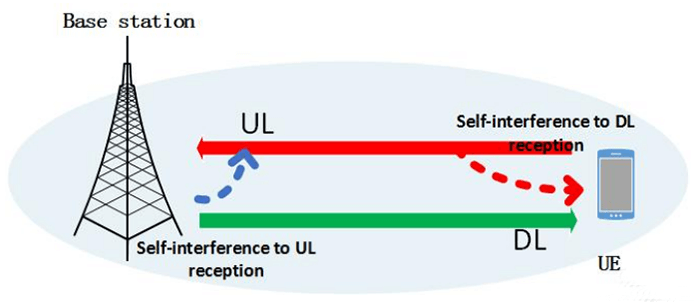Resource allocation in the duplex 5g NR is directly related to UL/DL direction indication, flexible duplex 5G, and full-duplex 5G.
UL/DL direction indication
In LTE, UL/DL direction is common to all UEs in the cell through semi-static signaling or dynamic signaling (in eIMTA: Enhanced Interference Management and Traffic Adaptation). In NR, it is proposed that the UL/DL direction can differ between UEs in the cell. This is used in the following scenarios.
1) UL and DL can be FDMed (Frequency domain multiplexing) in the same frequency band.
In this case, both UEs will have different resource usage directions in the same symbol.
2) The length of the DL-UL gap is determined by (downlink maximum propagation delay in the cell) + (RF switching period) + (UL maximum propagation delay in the cell).
Therefore, it is useful to optimize the gap for different UEs. For example, the gap can be reduced for UEs that do not have maximum propagation delay like the center of the UE.
For UEs that do not send ULs after the DL-UL interval, DLs can be received continuously during the interval. it is not necessary to always set a fixed gap.
On the other hand, allowing a group-specific UL/DL direction also helps to reduce the signaling overhead.
Therefore, considering both cases together, two approaches should be supported, i.e. group-specific or UE-specific UL/DL direction indication. A subcell should be used, in which the group-specific search space is shared between UEs. In the subcell, the “PCFICH-like signaling” is shared.
The direction indication may only indicate the period of the DL. The UE may not be required to know the uplink unless the UE explicitly instructs to send the UL.
How does flexible duplex 5G work?
Flexible duplex 5G can be understood as the following cases.
1) The use of UL and DL changes flexibly in the time domain in unpaired bands. This has the same meaning as dynamic TDD.
2) The use of UL and DL changes flexibly in the time domain of UL carriers in paired bands
3) The use of UL and DL is flexible in the time domain of DL carriers in paired frequency bands
4) UL and DL can be FDMed in the same unpaired bands, but cannot overlap.
5) UL and DL can be FDMed in the same UL carrier in paired bands, but they cannot overlap.
6) UL and DL can be FDMed in the same DL carrier in paired bands, but cannot overlap.
How does full-Duplex 5G work?
The full-duplex 5G situation is as follows.
Full-duplex 5G means that DL and UL transmit simultaneously in the same time/frequency resource. Related to the isolation between UL and DL, the usage scenarios can be divided into the following categories.
Case 1: Both the base station and the UE have full-duplex 5G pair eliminators.
Case 2: The base station has a full-duplex 5G eliminator, but the UE may not.
An example of a Case 1 deployment is shown in Figure 1. In the base station or UE side, there is some self-interference, e.g. from UL transmission on the UE side to DL reception, or interference from DL transmission to UL reception on the base station side. In this case, only one UE is shown in the network. depending on the situation, there may be multiple UEs that are performing MU-MIMO-like full-duplex based on the base station’s scheduling and MIMO capabilities.

In case 2, the UE does not need to have an eliminator. Therefore, the UE complexity issue is mitigated.
Figure 2 shows an example deployment in case 2. UE1 and UE2 do not have full-duplex 5G (or self-interference) cancellers, but the base station does. Interference from UE2 to UE1 can be avoided/reduced by base station scheduling.
In the base station, the situation is similar to case 1 and the base station can eliminate self-interference by its own cancellers.
Comparing case 2 and case 1, it is clear that the requirements for UE complexity are small. But on the other hand, case 1 allows more full-duplex 5G operation regardless of the transmitter/receiver UE.
As a result, the base station will have more flexibility in how it schedules its resources. Assuming that two UEs are scheduled simultaneously in the same subframe, case 1 can obtain twice the throughput than case 2 ideally.

Besides the What Does The Duplex 5G Model Look Like article, you may also be interested in the below articles.
4G vs 5G: What is the difference between 4G and 5G?
How to Choose the Best Antenna for Lora?
